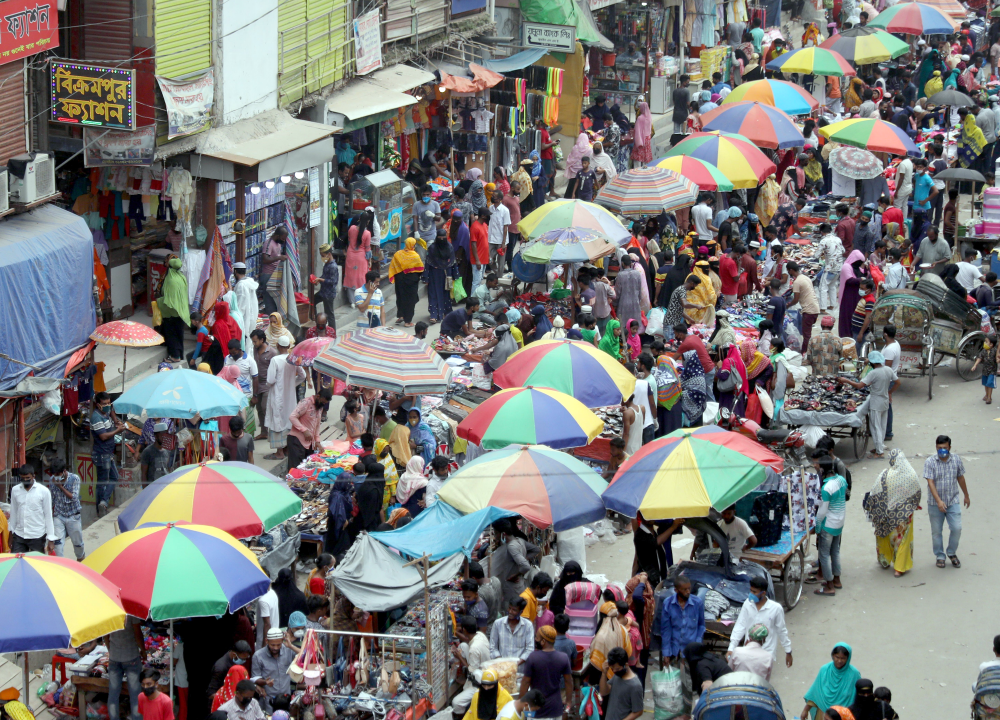New predictive modelling supports strategy of intermittent relaxing of Bangladesh lockdown
Total number of Covid-19 deaths could be kept below 5,000 say team of international academics

New predictive modelling by an international team of academics from eight countries has found that the Bangladesh government could relax the country’s lockdown whilst substantially restricting the total number of Covid-19 deaths – as long as the lockdown is intermittently re-imposed.
The modelling, which was published last week in the prestigious European Journal of Epidemiology, comes as the Bangladesh government announced on May 27th that from the end of the month, for a two week period, all offices and shops could reopen and limited public transport could resume. Restrictions on inter-district transport would remain as would the general “curfew” between 6pm to 8 am.
Commentators have raised concerns about the wisdom of relaxing the lockdown now with the number of reported Covid-19 deaths on an upward trend. In a recent webinar organised by the newspaper, The Dhaka Tribune, Dr Ashikur Rahman, a senior economist at the Policy Research Institute “pleaded” with the government to announce an even stricter lockdown over the next few weeks. Research by Imperial College, previously reported by Netra News, also suggests that a 50% loosening of the lockdown could lead, after two weeks, to a nearly 20 times increase in the daily number of infections.
The new modelling looked at how different strategies of relaxing the current lockdown in 16 countries would impact upon both the demand for hospital intensive care unit (ICU) beds and the numbers of deaths. It was conducted by a group of 14 academics based in the United Kingdom, Switzerland, Australia, the United States, Netherlands, Chile, Bangladesh and Sri Lanka who are part of the Global Dynamic Intervention Strategies for Covid-19 Collaborative Group.
In relation to Bangladesh, the modelling found that the most successful strategy would be to organise intermittent cycles involving 50 days of “suppression” – strict physical distancing including lockdowns – followed by 30 days of “relaxation”. This would result in a total number of deaths of 4,908 over an 18 month period, with 452 ICU beds needed each day during the peak of the epidemic. This is nine times the current level of deaths.
On May 28th, the official Covid-19 death tally was 559, a rate of death of 3 people per million of the population. If the number of deaths from the epidemic remained under 5,000, the country’s death final rate from the virus would be 30 deaths per million, a level far lower than many other countries: Belgium currently has a death rate of 810 deaths per million, United Kingdom a death rate of 552 deaths and the United States has a death rate of 309 deaths per million.
The alternative strategy modelled by the researchers looked at removing the lockdown completely, and instead carrying out intermittent cycles of 50 days “mitigation” followed by 30 days of “relaxation”. This, the researchers found, would result in 226,700 deaths and a daily need for 33,631 ICU beds at the epidemic’s peak. Mitigation here refers to a combination of measures such as general social distancing measures, hygiene rules, case-based isolation, shielding of vulnerable groups, school closures or restricting of large public events.
“We provide an actionable strategy option for COVID-19 control by employing dynamic interventions that could delay the epidemic peak while allowing tine to enhance health systems capacities and efforts to develop therapies or vaccines,” the paper states. “These dynamic measures also allow interim period of relaxation in order to minimise socio-economic disruptions and maximise population compliance to these stringent measures.”
Bangladesh government officials were aware of the modelling before making its announcement to relax the lockdown, but it is not known whether the research informed its policy making. It is notable that the government current announcement allows a change of policy in the middle of June.
The academic paper, titled “Dynamic Interventions to control Covid-19 pandemic: a multivariate prediction modelling study comparing 16 worldwide countries,” stated that whilst 30 days was calculated as the “optimal break duration”, each country could consider other timings “depending [on] the special settings and availability of resources.”
The joint first authors are Rajiv Chowdhury and Kevin Heng. Chowdhury, of Bangladeshi origin, is Associate Professor in Global Health at the Department of Public Health and Primary Care at the University of Cambridge. Two of the other authors work or live in Bangladesh – Abbas Bhuiya, an independent health and population researcher in Dhaka and Daniel Reidpath, Senior Director, Health Systems and Population Studies Division, at the International Centre for Diarrhoeal Disease Research in Dhaka.
An earlier analysis, published by UK’s Imperial College at the end of March, found that a sustained lockdown in Bangladesh over an 18 month period, without any gaps, could result in around 52,000 deaths.●
🔗Dhaka Tribune: Live Webinar – Last Window to Tame the Beast
🔗MRC Centre for Global Infectious Disease Analysis: Situation Report for COVID-19: Bangladesh, 2020-05-20 (Please note this report is updated on a daily basis, so numbers will likely be different if you access this page on subsequent dates )
🔗Netra News: UN Interagency Memo: Without interventions up to 2 million people may die
🔗Netra News: Bangladesh’s Covid-19 future is in the government hands